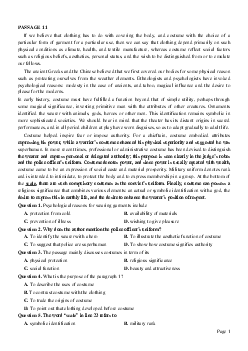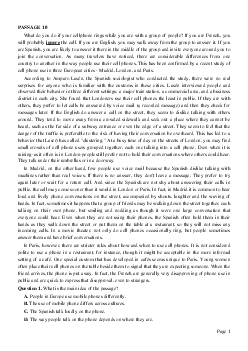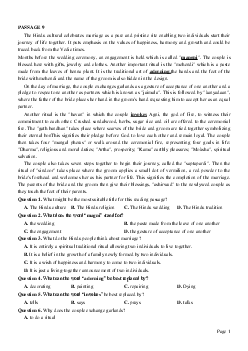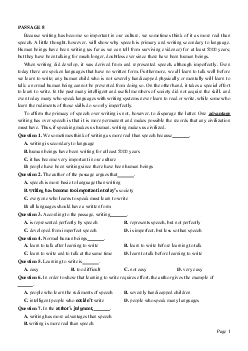


Preview text:
PASSAGE 15
Animation traditionally is done by hand-drawing or painting successive frames of an object, each slightly
different than the preceding frame. In computer animation, although the computer may be the one to draw
the different frames, in most cases the artist will draw the beginning and ending frames and the computer
will produce the drawings between the first and the last drawing. This is generally referred to as
computer-assisted animation, because the computer is more of a helper than an originator.
In full computer animation, complex mathematical formulas are used to produce the final sequence of
pictures. These formulas operate on extensive databases of numbers that define the objects in the pictures
as they exist in mathematical space. The database consists of endpoints, and color and intensity
information. Highly trained professionals are needed to produce such effects because animation that
obtains high degrees of realism involves computer techniques for three-dimensional transformation, shading, and curvatures.
High-tech computer animation for film involves very expensive computer systems along with special
color terminals or frame buffers. The frame buffer is nothing more than a giant image memory for
viewing a single frame. It temporarily holds the image for display on the screen.
A camera can be used to film directly from the computer's display screen, but for the highest quality
images possible, expensive film recorders are used. The computer computes the positions and colors for
the figures in the picture, and sends this information to the recorder, which captures it on film.
Sometimes, however, the images are stored on a large magnetic disk before being sent to the recorder.
Once this process is completed, it is repeated for the next frame. When the entire sequence has been
recorded on the film, the film must be developed before the animation can be viewed. If the entire
sequence does not seem right, the motions must be corrected, recomputed, redisplayed, and rerecorded.
This approach can be very expensive and time consuming. Often, computer-animation companies first do
motion tests with simple computer-generated line drawings before selling their computers to the task of
calculating the high-resolution, realistic-looking images.
Question 1. What aspect of computer animation does the passage mainly discuss?
A. The production process
B. The equipment needed C. The high cost
D. The role of the artist
Question 2. According to the passage, in computer-assisted animation the role of the computer is to draw the . A. first frame B. middle frames C. last frame
D. entire sequence of frames
Question 3. The word "they" in the second paragraph refers to . A. formulas B. databases C. numbers D. objects
Question 4. According to the passage, the frame buffers mentioned in the third paragraph are used to .
A. add color to the images
B. expose several frames at the same time
C. store individual images D. create new frames
Question 5. According to the passage, the positions and colours of the figures in high-tech animation are determined by .
A. drawing several versions
B. enlarging one frame at a lime Page 1
C. using computer calculations
D. analyzing the sequence from different angles
Question 6. The word "captures" in the fourth paragraph is closest in meaning to . A. separates B. registers C. describes D. numbers
Question 7. The word "Once" in the fourth paragraph is closest in meaning to . A. before B. since C. after D. while
Question 8. According to the passage, how do computer-animation companies often test motion?
A. They experiment with computer-generated line drawings.
B. They hand-draw successive frames.
C. They calculate high-resolution images.
D. They develop extensive mathematical formulas.
Question 9. The word "task" in the 4th paragraph is closest in meaning to . A. possibility B. position C. time D. job
Question 10. Which of the following statements is supported by the passage?
A. Computers have reduced the costs of animation.
B. In the future, traditional artists will no longer be needed.
C. Artists are unable to produce drawings as high in quality as computer drawings.
D. Animation involves a wide range of technical and artistic skills. ĐÁP ÁN 1-A 2-B 3-D 4-C 5-C 6-B 7-C 8-A 9-D 10D Question 1:
Dựa vào câu đầu của bài khóa: “Animation traditionally is done by hand-drawing or painting successive
frames of an object, each slightly different than the preceding frame” => Bài khóa bàn về quy trình sản xuất phim hoạt hình Question 2:
“in most cases the artist will draw the beginning and ending frames and the computer will produce the
drawings between the first and the last drawing” => Họa sĩ thường vẽ phần đầu và cuối, còn máy tính vẽ
phần giữa đầu và cuối => phần giữa Question 3:
“These formulas operate on extensive databases of numbers that define the objects in the pictures as they
exist in mathematical space” => Các công thức toán học phức tạp thực hiện trong các ổ dữ liệu lớn các số
mà xác định các vật (objects) khi mà chúng (các vật này) tồn tại trong không gian toán học. Question 4:
“The frame buffer is nothing more than a giant image memory for viewing a single frame. It temporarily
holds the image for display on the screen.” => vùng đệm khung là một bộ nhớ ảnh khổng lồ tạm thời chứa
các ảnh để hiển thị trên màn hình Question 5: Page 2
“The computer computes the positions and colors for the figures in the picture, and sends this information
to the recorder, which captures it on film” => Vị trí và hình ảnh của các nhanh vật trong phim hoạt hình
công nghệ cao được xác định bằng các tính toán máy tính (computers computes). Question 6:
Capture = register (v): nắm bắt, lưu giữ Question 7:
“Once this process is completed, it is repeated for the next frame.” => Ngay sau khi quy trình này được
hoàn thành, nó đượ lặp lại cho khung tiếp theo. Question 8:
“Often, computer-animation companies first do motion tests with simple computer-generated line
drawings” => Các công ty sản xuất phim hoạt hình kiểm tra hoạt động vằng các bức vẽ các đường tạo ra bởi máy tính. Question 9:
Task = job: công việc, nhiệm vụ Question 10:
Skimming bài khóa ta thấy đáp án D. sản xuất phim hoạt hình liên quan nhiều đến những kỹ năng kỹ
thuật và nghệ sĩ hợp lý nhất. Page 3




